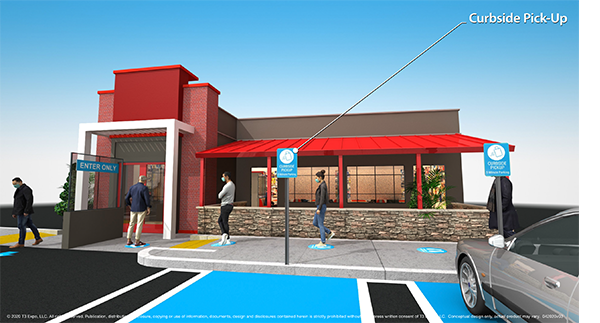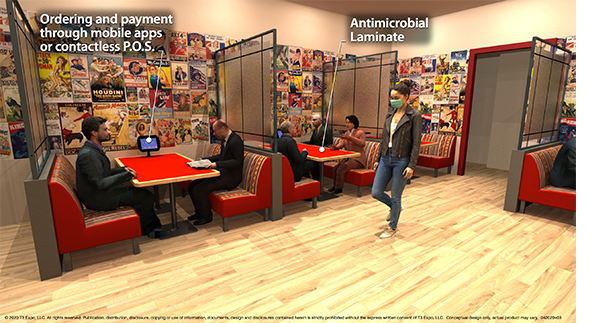Background
As one of largest sectors of the American economy, it is vital to get the restaurant sector safely back up and running. With franchise restaurant brands spanning quick service to dine in, there are still broad recommendations allowing for continued safe operation or safe reopening.
General Recommended Guidelines
- Practice social distancing throughout the establishment.
- Post signage at the door stating that any customer who has experienced COVID-19 symptoms is not permitted to enter
- As available, hand sanitizer should be prominently provided throughout the restaurant.
- Utilize wayfinding visuals and architectural cues to direct customers through the food service experience.
- Continue to offer curbside pickup and/or contactless delivery.
Safe Routines Upon Arriving at Work
- Employees should be trained on the importance of frequent hand washing, the use of hand sanitizers with at least 60% alcohol content, and be given clear instruction to avoid touching hands to face.
Safe Working Environment
- Per CDC recommendations, face coverings have been shown to be effective tools to mitigate risk from individuals who show symptoms as well as those who don’t, especially in close environments where it’s hard for people to maintain a three- to six-foot distance. In some states and local jurisdictions, face coverings are required by government officials; some employers require them, too. In all cases, those coverings worn by employees should be kept clean in accordance with CDC guidance.
- Workstations/food prep areas should be placed 6 feet apart when feasible. When that is not an option, dividers may be used to mitigate contact.
- Strong procedures for sanitizing surfaces should be implemented.
- Per existing FDA Food Code requirements, employees who are sick should remain at home.
- Taking employees’ temperatures is at the operators’ discretion. The CDC has not mandated taking an employee’s temperature and any operator who chooses to do so should engage health officials first and adopt policies aligned with proper procedures. CDC guidance states the minimum temperature that indicates a fever is 100.4°F.
- High customer contact areas should be sanitized with Environmental Protection Agency (EPA) approved cleaners frequently.
- Employees should be provided access to any new guidelines before returning to work.
- Employers should certify employees in on-going ServSafe or similar approved food safety training guidelines for proper safe food handling.
- Operators should establish guidelines for the receiving of products from vendors and post prominently.
- Employers should designate one employee per shift responsible for monitoring all guidelines being adhered to by employees, customers, and vendors.
- Where feasible, avoid in-person pre-shift meetings. Instead utilize communication boards to prevent the congregation of employees.
- Gloves should be worn at all times during food preparation.
- Number of employees allowed simultaneously in break rooms should be limited.
Customer Guidelines
- Prominently post guidelines at the entrance to the establishment. Include information on how to stop the spread of COVID-19.
- When possible create one-way traffic through the establishment. Utilizing a separate entrance and exit each marked prominently with distinctive signage.
- Make hand sanitizer readily available in the establishment. Consider touchless solutions.
- Whenever possible encourage reservations.
- Provide visual guidelines to maintain social distancing if queuing in line to place orders.
- Do not allow customers to congregate in waiting areas. Encourage waiting outside with visual social distancing queues. Remove furniture as needed to prevent congregating.
- Consider limits on party size.
- Remove self-service areas whenever possible.
- Consider updating floor plans for common dining areas, redesigning seating arrangements to ensure at least six feet of separation between table setups. Where practical, especially in booth seating, physical barriers can be used.
- Consider one-time use menus and discard after each use. If reusable menus are utilized, sanitize after each customer.
- Where feasible, disable or block self-service drink, condiment, utensil, and tableware stations and have workers provide items to customers directly.
- Continue to offer and expand upon curbside pickup and delivery service options.
- Restrooms:
- Ensure a proper supply of soap and hand towels is available at all times and restrooms are cleaned/sanitized frequently.
- Payment:
- Payments should be processed via touchless systems where feasible.
- Cash payments should be facilitated via a tray versus direct contact.




